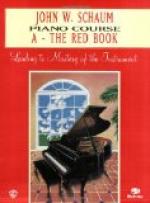“You ask how I would begin with a young pupil who never has had lessons. I use the principle of relaxation first of all, loosening arms and wrists. This principle can be taught to the youngest pupil. The wrist is elevated and lowered, as the hand is formed on the keys in its five finger position, with arched knuckles. It does not take long to acquire this relaxed condition; then come the finger movements. I do not believe in lifting the fingers high above the keys; this takes time and interferes with velocity and power. I lift my fingers but little above the keys, yet I have plenty of power, all the critics agree on that. In chords and octaves I get all the power I need by grasping the keys with weight and pressure. I do not even prepare the fingers in the air, before taking the chord; I do not find it necessary.” Here the pianist played a succession of ringing chords, whose power and tonal quality bore out her words; the fingers seemed merely to press and cling; there was no striking nor percussion.
“To return to the beginning pupil. As for a book to start with, I often use the one by Damm, though any foundational work may be employed, so long as correct principles are taught. It is said by Leschetizky that he has no method. That may be understood to mean a book, for he certainly has what others would call a method. There are principles and various sets of exercises to be learned; but it is quite true that none of the Vorbereiters use a book.
“In teaching the piano, as you know, every pupil is different; each has his or her own peculiar hand, and a different degree of intelligence. So each pupil must be treated differently. This is really an advantage to the teacher; for it would be very monotonous if all pupils were alike.
“The piano is such a revealer of character; I need only to hear a person play to know what sort of character he has. If one is inclined to much careful detail in everything, it comes out in the playing. If one is indolent and indifferent, it is seen the moment one touches the keys; or if one is built on broad, generous lines, and sees the dramatic point in life and things, all this is revealed at the piano.
“To refer again to the subject of finger action. I do not believe in the so-called finger stroke; on the contrary I advocate fingers close to the keys, clinging to them whenever you can. This is also Arthur Schnabel’s idea. You should hear Schnabel; all Berlin is wild over him, and whenever he gives a concert the house is sold out. He has quantities of pupils also, and is quite a remarkable teacher. One point I insist upon which he doesn’t: I will not allow the joint of the finger next the tip to break or give in. I can not stand that, but Schnabel doesn’t seem to care about it; his mind is filled with only the big, broad things of music.




